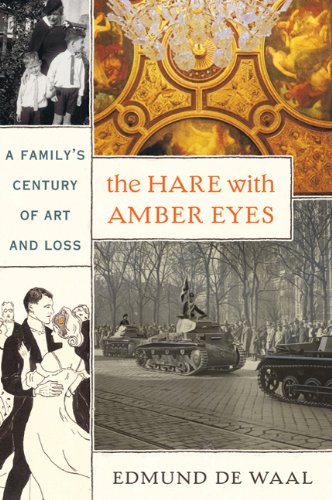 I had The Hare with Amber Eyes on my bookshelf for about a year and initially, I wasn’t too keen on reading it. Here’s the premise: the author (Edmund de Waal) inherits from his great-uncle 264 netsuke—small wood and ivory carvings from Japan, and he traces their history. For some reason, it didn’t sound that intriguing to me, but then I ran into a colleague slipping away to read during her lunch break: what was the book? The Hare with Amber Eyes.
I had The Hare with Amber Eyes on my bookshelf for about a year and initially, I wasn’t too keen on reading it. Here’s the premise: the author (Edmund de Waal) inherits from his great-uncle 264 netsuke—small wood and ivory carvings from Japan, and he traces their history. For some reason, it didn’t sound that intriguing to me, but then I ran into a colleague slipping away to read during her lunch break: what was the book? The Hare with Amber Eyes.
Curiosity piqued, I dusted off my copy and started in on an amazing journey. De Waal descends from the illustrious Ephrussi family, famous for its vast fortunes in the 19th and early 20th centuries from grain distribution, shipping, and banking. The book is particularly relevant to fans of the Phillips since de Waal starts his story in Paris, in the home of Charles Ephrussi. Familiar with the cast of characters from Pierre-Auguste Renoir’s Luncheon of the Boating Party? Then you’ll recognize Charles as the figure towards the back of the painting wearing a top hat and suit. Ephrussi purchased the netsuke from a dealer in the 1870s, and de Waal’s writing transports us to fin de siècle Paris where we get to know Charles and his circle of luminaries, including Marcel Proust, Édouard Manet, and of course, Renoir.
Next stop is Vienna, 1899. Charles sent the netsuke to his favorite cousin Viktor as a wedding gift. Nestled away in his wife’s dressing room, the couple’s children regularly played with the objects while their well-dressed mother preened for evenings out on the town. De Waal familiarizes readers with the family’s lavish life in a culturally sophisticated city, but as time progresses, anti-Semitism and the Nazi occupation of Austria force the Jewish family to abandon the Continent for England.
In the last part of the 20th century the netsuke make their home in Japan before finding their way to de Waal in London in 1994. De Waal’s eloquently penned words demonstrate how objects and their stories allow us to travel across time and history, allowing us to identify with the gripping lives of their owners. As de Waal put it near the end of the book, “I no longer know if this book is about my family, or memory, or myself, or is still a book about small Japanese things.”
Check out this video to hear de Waal describe the process of writing the book. And as an added bonus you get to see the netsuke!

Merci encore pour cette publication très interressante,je ne savais pas ce qu’était un Netsuke ! Il faut visiter la villa Ephrussi-de Rotchild à St jean cap ferrat, en France ,elle est magnifique !
I was in Vienna about 8 months ago following the Ephrussi trail. It is difficult to imagine that kind of opulence and wealth. The Ephrussi house now is the headquarters for the Gentral Gambling Association.
Last weekend, i read a paper at the North American Victorian Studies Association meeting in Nashville. I mentioned de Waal’s book in the context of George Moore’s CONFESSIONS OF A YOUNG MAN (18880, which deals with the same Paris milieu from 1873 to 1879.
Pingback: The Results of our Experiment « The Experiment Station
I loved this book, both in content and the quality of the writing. It is a fascinating story which holds one’s interest the entire way through. Thanks for reviewing it.